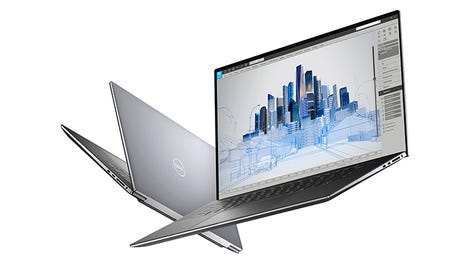
Dell describes the Precision 5760 as its “thinnest, smallest and lightest” mobile workstation.
Image: Dell
When only the most powerful laptop will do, professionals reach for a mobile workstation. These don’t come cheap, but they do pack serious specifications that will help the likes of 2D and 3D designers, photo and video editors, scientists and financial analysts get their work done.
Dell’s Precision 5760 is a case in point. A 17-inch 4K screen, up to 8TB of SSD storage, discrete Nvidia RTX graphics and up to a Core i9 processor are all in the mix. Dell says the Precision 5760 is its thinnest, smallest and lightest 17-inch mobile workstation. But all those top-notch specifications come at a price. Configurations in the UK start at £2,352.64 (inc. VAT) rising to a Core i9 model costing £4,726.76 (inc. VAT) and there are multiple build-your-own (BYO) options.
In the US, prices currently range between $2,059 (Core i5, integrated graphics, FHD+ screen) and $3,299 (Core i7, discrete graphics, FHD+ screen), while a customised full-spec BYO model will cost you a princely $6,719 (Xeon W, Nvidia RTX A3000, 4K touch screen, 64GB RAM, 4TB of PCIe SSD storage). You can even add another 4TB of SSD storage to take the price up to $9,053 if need be.
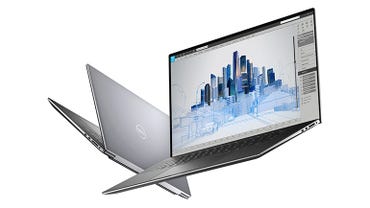
Gone are the days when mobile workstations were bulky and heavy devices with aesthetics very much an afterthought. Obviously the 17-inch screen here requires a sizeable chassis, and that, along with a big 97Wh battery, ensures that the Precision 5760 is no lightweight.
Still, a starting weight of 2.13kg (4.7lbs) seems reasonable, while the desktop footprint of 374.48mm wide by 248.08mm deep (14.74 x 9.77 inches) shows that the 17-inch screen keeps the bezels to a minimum. The chassis tapers to 8.67mm (0.34 inches) thick at the front, while at the back is 13.15mm (0.51 inches) thick.
The Precision 5760’s size obviously makes it awkward to carry around. But if you must, you’ll want plenty of protection for this pricey laptop, so a well-padded bag will be a requirement. You’ll also need space in your bag for the chunky power adapter.
Although protection in transit is advised, there’s no suggestion that Dell has any cut corners regarding build quality, which is superb. I couldn’t bend or bow the large lid section in my hands, and the laptop generally feels solid. There are no design surprises: the silver lid sports the central circular Dell logo, while inside Dell’s familiar hatching pattern covers the wrist rest and the area above the keyboard.
The screen is — as it should be on a workstation — superb. I’ve already noted the minimal bezels. Dell’s InfinityEdge design reduces both short and long edge bezels, resulting in an impressive screen-to-body ratio: Dell claims ‘>94%’, while we measured it at a still-impressive 90.2%.
The upper long bezel leaves only just enough room for the 720p webcam, which includes IR support for Windows Hello face authentication. On such a high-end laptop Dell could arguably have gone further than 720p resolution and also added a privacy cover. That said, the IR camera packs some handy features, including Intel Context Sensing Technology, which is used to deliver some presence-detection features. The camera spots when the user is nearby and will wake up the laptop and, if Windows Hello is set up, log them in. When you walk away, it’ll detect that too, and lock the laptop down.
The lower long bezel is also tiny, and Dell has been able to provide a display with an aspect ratio of 16:10. I managed to work some of the time with three documents open side by side, and while that did feel like a bit of a squeeze, having two documents open simultaneously is comfortable.
Video looks stunning, and the edge-to-edge viewing area is only part of the story here. The UHD+ resolution (3,840 x 2,400, 266ppi) delivers crisp, sharp content, while 100% Adobe RGB and 99% DCI-P3 coverage take care of colour rendering. With all 500 nits of brightness maxed out, the screen was too bright for work sessions in my home office and needed turning down. The screen in my review unit was touch responsive, which is good, but it’s a shame that Dell doesn’t bundle a stylus.
A good screen deserves good speakers, and the setup here does not disappoint. There are wide grilles left and right of the keyboard, which output sound from two woofers and two tweeters. Bass tones come through well, and every kind of audio, from movie watching through to full orchestral, was enjoyable. I noticed no distortion at top volume, which is reasonably loud. The only drawback with the speaker grille positioning is the lack of space to accommodate a separate number pad – something often seen on 17-inch laptops.
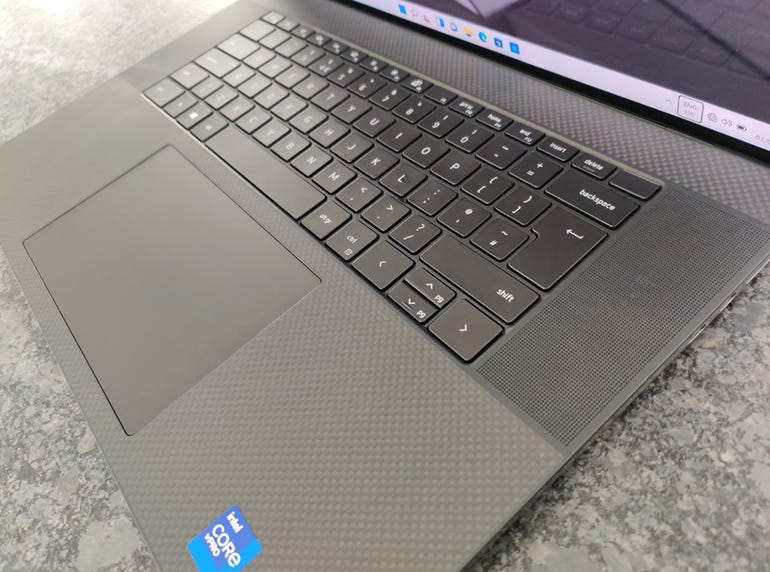
The backlit keyboard is flanked by large speaker grilles that rule out a separate number pad. The touchpad is huge.
Image: Sandra Vogel / ZDNet
Still, the backlit keyboard is well laid out and easy to use. The left and right arrow keys are, unusually, somewhat larger than the QWERTY keys. The Fn row keys are also sizeable. There’s a fingerprint sensor built into a blank key at the far right of the Fn row, for those who prefer this method to face authentication.
The 1.3mm of key travel is plenty for comfortable touch typing. There is a small amount of resistance on the downstroke and a nice bounce-back that makes typing feel effortless. The gentle ‘thunk’ that emanates from each key is barely noticeable. The touchpad is huge and superbly responsive both to clicks and gestures.
There are three base configurations available in the UK at the time of writing, and you’ll need to forego a touch screen and 4K display at the entry level:
- Intel Core i5-11500H, Windows 10 Pro, 17-inch 1,920 x 1,200 pixel non-touch screen, Intel UHD graphics, 8GB RAM, 256GB SSD
£2,352.64 (inc. VAT) - Intel Core i7-11850H, Windows 10 Pro, 17-inch 3,480 x 2,400 pixel touch screen, Nvidia RTX A2000 4GB graphics, 16GB RAM, 512GB SSD
£3,778.76 (inc. VAT) - Intel Core i9-11950H, Windows 10 Pro, 17-inch 3,480 x 2,400 pixel touch screen, Nvidia RTX A2000 6GB graphics, 32GB RAM, 512GB SSD
£4,726.76 (inc. VAT)
Options include Windows 10, Windows 11 or Ubuntu Linux, boosting the RAM to 64GB and getting all the way to 8GB of internal storage by configuring a pair of 4GB drives. This sends the overall price sky-high though. Adding a single 4TB instead of the base 256GB drive will cost £807.30 (inc. VAT), while the second 4TB drive adds a further £929.76 (inc. VAT) to the cost.
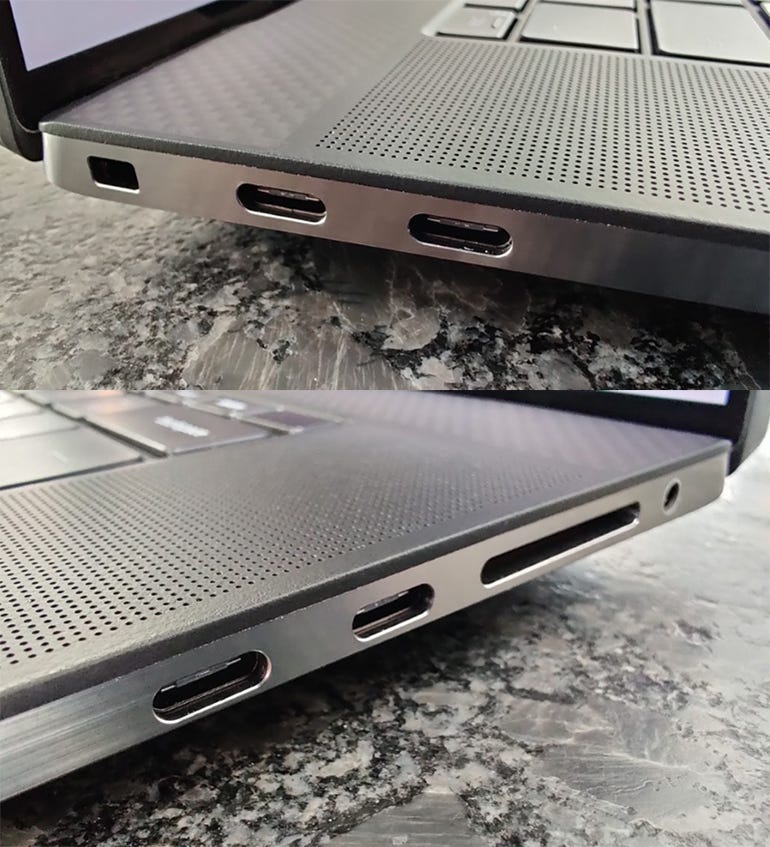
Left side (top): 2x Thunderbolt 4 (USB-C). Right side (above): 2x Thunderbolt 4 (USB-C), SD card reader, 3.5mm headphone jack.
Images: Sandra Vogel / ZDNet
Whatever decisions you make on configuration, there’s no getting away from the ports setup. Some will love the fact that there are four Thunderbolt 4 ports. One of these is occupied while the Precision 5760 is being charged, but the other three remain available. There’s also an SD card reader and a 3.5mm headset jack. There are no other ports: if you need to make other wired connections, you’ll need to invest in a docking station.
Battery life might be an issue if you need to use the Precision 5760 for extended periods away from a power outlet. My review unit had a power-hungry 4K display, and after fully charging the 97Wh battery I worked for three hours on my usual mainstream productivity workload. This is far below what this laptop is expected to handle, but users will still likely want to spend some time writing into web apps, opening multiple browser tabs and streaming media and so on. My 3-hour work session saw the battery fall from 100% to 40% over three hours, suggesting moderate total battery life of around 5 hours.
This doesn’t bode well if you need long mains-free work sessions, but there is some good news on the charging front. With the battery at 36% I plugged in and after 15 minutes it had risen to 49%, after 30 minutes it was at 61% and after 45 minutes it had reached 73%.
Working with my Core-i9 based review unit, the fan kicked in a few times when the laptop was charging, although never while I was working on battery power. When it was running, the fan noise was pretty loud, and rather disturbing in my otherwise quiet home office.
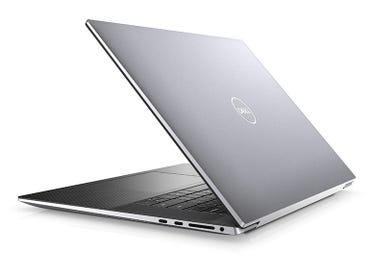
Image: Dell
Conclusions
The Dell Precision 5760 is a 17-inch mobile workstation with a lot to offer. The near bezel-free screen is superb in its 4K iteration, as sent to me for review, and the speakers do it proud. Configuration options extend to a Xeon W processor, Nvidia RTX A3000 graphics and 8TB of storage, the keyboard is exceptional and the build is very solid.
There are a few downsides, however. The 720p webcam is average, battery life is lacklustre, and those seeking more muscular configurations will need to dig deep into their pockets. Working with the 4K screen I would struggle to get a full day’s work out of a full battery charge. Even the base model in the UK costs £2,352.64 (inc. VAT) and its Core i5 processor, integrated graphics, non-touch FHD+ screen, 8GB of RAM and 256GB of storage are far below what most workstation users will require.
RECENT & RELATED CONTENT
Dell Precision 5750 review: A mobile workstation combining heavyweight performance with slimline design
Asus ProArt Studiobook 16 OLED (H5600) review: A top-quality 16-inch mobile workstation for creative pros
Best laptop docking station 2022: Get well-connected
Best laptop for graphic design 2022: Get creative
Best laptops 2021: The top 5 laptops for all users
Read more reviews
